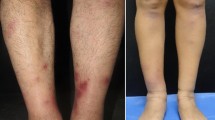Abstract:
Erythema nodosum (EN) is a cutaneous reaction consisting of inflammatory, tender nodular lesions and is associated with a wide variety of disease processes. The aim of our study was to investigate the frequency of different aetiologies of EN. One hundred and thirty-two EN patients were investigated in a prospective study during the period 1984–1990. The evaluation of all patients began with a medical and family history and completed with a thorough physical examination and detailed laboratory and immunological work-up. In addition, various diagnostic procedures were performed where and when indicated. One hundred and ten patients (83%) were women. Their mean age was 41.0 ± 14.0 years, range 18–79 years. In 35% the cause of EN was not found. Sarcoidosis was revealed in 28% of the patients, infections in 17.3% and tuberculosis in 1.5%. Other aetiologic factors were Adamantiadis–Behçet’s syndrome (3.8%), pregnancy (6%), oral contraceptives (3.8%) and other drugs (3.8%). The aetiology of EN was not found in 35% of the patients. Sarcoidosis and infections were frequent causes of EN, whereas autoimmune rheumatic diseases rarely cause EN.
Similar content being viewed by others
Author information
Authors and Affiliations
Additional information
Received: 31 May 1999 / Accepted: 2 December 1999
Rights and permissions
About this article
Cite this article
Psychos, D., Voulgari, P., Skopouli, F. et al. Erythema Nodosum: the Underlying Conditions. Clin Rheumatol 19, 212–216 (2000). https://doi.org/10.1007/s100670050159
Issue Date:
DOI: https://doi.org/10.1007/s100670050159




